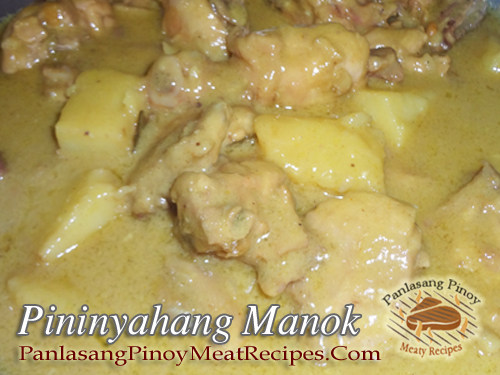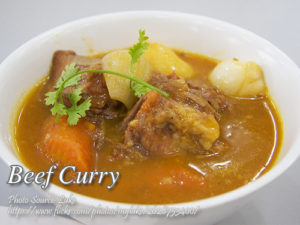Pininyahang manok is actually a dish of stewed chicken in pineapple. There are many variation of cooking pininyahang manok and this version I got here doesn’t contain evaporated milk or coconut milk. The only star ingredients here is pineapple chunks and pineapple juice. There are also no veggies like carrots or potatoes. The chicken is also braised before cooking in pineapple juice unlike the usual cooking of marinating it first before stewing. Since is doesn’t have milk, this recipe is for those people with lactose intolerance.
Pininyahang Manok: A Simple Taste of Nostalgia
Growing up in Tarlac, Sundays at our family home always felt like a culinary adventure. My Tita Nena, a natural in the kitchen, had a way of transforming simple ingredients into unforgettable dishes. One of her masterpieces was pininyahang manok, a dish so simple yet so delicious that it felt like a celebration every time it was served.
This pineapple chicken stew holds a special place in my heart. It’s not just about the tender, flavorful chicken or the sweet and tangy pineapple-infused sauce—it’s the memories of family gatherings, laughter echoing in the kitchen, and the aroma of ginger and soy sauce wafting through the air that make it so special.
What Makes Pineapple Chicken Unique
Pineapple chicken is a classic Filipino dish known for its balance of sweet and savory flavors. Unlike other variations that call for coconut milk or evaporated milk, this version sticks to the basics—pineapple chunks and pineapple juice are the stars. This simplicity makes the dish ideal for those who are lactose-intolerant or simply prefer a lighter, fresher take on the recipe.
What sets this version apart is the technique of braising the chicken before stewing it in the pineapple juice. This step helps seal in the juices and enhances the dish’s depth of flavor.
A Little History of Pininyahang Manok
The origins of pininyahang manok are a testament to the Filipino ingenuity in combining flavors and making the most of available ingredients. Pineapple, a tropical fruit abundant in the Philippines, has been a staple in Filipino cooking for centuries, often used to add sweetness to savory dishes. The dish is believed to have evolved during the American colonial period, when canned goods, including pineapples, became more accessible. Over time, the recipe took on regional variations, with some versions including vegetables like carrots or potatoes, and others incorporating creamy sauces.
My family’s version, however, has always been straightforward and unfussy, letting the natural flavors of the pineapple and chicken shine through.
A Step-by-Step Guide to Cooking Pininyahang Manok
Cooking pineapple chicken starts with proper preparation. My Kuya Jun, who swears by precise techniques in cooking, always says that washing the chicken thoroughly and patting it dry is non-negotiable. It’s a small step that makes a big difference in achieving a good sear.
The chicken pieces are then fried until they develop a slight golden-brown crust. This technique, though simple, is crucial—it locks in the chicken’s natural juices, giving it a rich, satisfying texture. After frying, the chicken is set aside while the ginisa magic happens.
Onions and ginger are sautéed in the same pan, their aromas signaling that something wonderful is on the way. Once the chicken is added back, the soy sauce, cilantro, salt, sugar, and pineapple juice come into play. The pineapple juice, with its natural acidity, not only tenderizes the chicken but also infuses it with a distinct tangy-sweet flavor that makes this dish unforgettable.
My Ate Lorna swears by a splash of 7-Up during the cooking process. She insists it adds a subtle sweetness and helps achieve a thicker, glossier sauce. And she’s right—it’s one of those little tricks that elevates the dish from good to great.
Finally, pineapple chunks and a cornstarch slurry are added to the mix. The slurry thickens the sauce to the perfect consistency, while the pineapple chunks add bursts of sweetness with every bite. After a few more minutes of simmering, the dish is ready to be served.
Tips for Perfecting Your Chicken Dish
While this recipe is wonderfully simple, a few tips can help ensure it turns out perfectly every time.
- Use fresh chicken for the best flavor and texture. Frozen chicken works, too, but make sure to thaw it properly to avoid excess moisture during frying.
- Don’t skip the frying step. The caramelized exterior adds a layer of flavor that complements the pineapple sauce beautifully.
- Adjust the sweetness to your liking. If you prefer a less sweet dish, you can reduce the amount of pineapple juice or sugar slightly.
Food for Thought: Why Pineapple Works in Savory Dishes
If you’ve ever wondered why pineapple pairs so well with chicken, it’s all about balance. The fruit’s natural acidity cuts through the richness of the meat, while its sweetness enhances the dish’s overall flavor profile. Pineapple also contains an enzyme called bromelain, which helps tenderize proteins, making it a fantastic ingredient for stews like pininyahang manok.
A Dish That Brings Families Together
Whenever I cook pineapple chicken, I’m reminded of those Sunday lunches at home. My siblings and I would crowd around the table, eager to scoop up the sweet and savory sauce over mounds of steamed rice. To this day, it remains a dish that brings people together—a true comfort food that’s as much about the memories as it is about the taste.
So, whether you’re making this dish for the first time or revisiting a family favorite, pininyahang manok is a recipe that’s sure to delight. Simple, flavorful, and steeped in tradition, it’s a testament to the magic of Filipino cooking. Give it a try, and let the flavors of pineapple chicken transport you to a warm, bustling Filipino kitchen.
How to Cook Pininyahang Manok (Chicken Pineapple Recipe)
Ingredients
- 1 kilo chicken sliced in 2 inches
- 1/2 cup cilantro chopped
- 1/2 cup onion chopped
- 1 Tbsp. dried ginger
- 1 Tbsp. cornstarch dissolved in ¼ cup water
- 1 cup cooking oil
- 2 Tbsp. salt
- 1 Tbsp. sugar
- 2 Tbsp. soy sauce
- 2 cups pineapple chunks
- 1 cup pineapple juice
- 1 cup 7-UP or sprite
Instructions
How to cook Pininyahang Manok:
- Wash the chicken thoroughly and drain.
- In a big wok or kawali, heat the oil and fry the chicken until slightly brown.
- Remove from the wok and set aside.
- Sauté the onion and ginger and add the chicken.
- Pour in the silantro, soy sauce, salt, sugar and pineapple juice.
- Cook until chicken is tender. Add the cornstarch slurry, 7-Up and pineapple chunks.
- Then simmer until the sauce thickens. Serve.
Notes
Cooking Tips:
Sear the Chicken for Maximum Flavor
Before stewing, lightly fry the chicken until golden brown. This step seals in the juices, giving the chicken a tender interior while adding a rich, caramelized layer of flavor to the dish. Skipping this step might result in a less flavorful and less appealing texture.Use Pineapple Juice as a Tenderizer
The natural acidity of pineapple juice works wonders in tenderizing the chicken. Let the meat simmer in the juice long enough to absorb its sweet and tangy flavor fully. This technique not only enhances taste but also ensures a melt-in-your-mouth texture.Add 7-Up for a Unique Twist
A splash of 7-Up during cooking balances the tangy pineapple with a subtle sweetness and helps thicken the sauce. The soda's carbonation also acts as a tenderizing agent, ensuring the chicken stays moist. It’s an unexpected but effective ingredient for elevating this classic dish.





